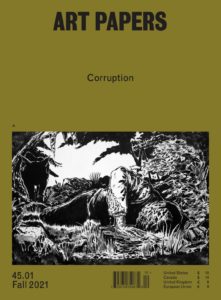Corruption
Share:
In the late spring of 2020, when considering the ART PAPERS Fall 2021 theme,  corruption was on my mind. During the final year of a US presidency that many historians believe to be the most corrupt in 100 years, marked by more than 3,700 recorded financial conflicts of interest, it seemed that corruption ruled. The political situation, combined with Covid-19’s harsh reveal of systemic inequalities—formerly so starkly evident only to those most affected—shone a light upon the shady underbelly beneath seemingly every aspect of contemporary society.
corruption was on my mind. During the final year of a US presidency that many historians believe to be the most corrupt in 100 years, marked by more than 3,700 recorded financial conflicts of interest, it seemed that corruption ruled. The political situation, combined with Covid-19’s harsh reveal of systemic inequalities—formerly so starkly evident only to those most affected—shone a light upon the shady underbelly beneath seemingly every aspect of contemporary society.
This issue mines various interpretive possibilities of corruption, following two separate, but intertwined, lines of inquiry. The first looks to artists who explore corruption defined as fraud, exploitation, or criminality through strategies of satire, exposure, and personal narrative. Will Corwin interviews Mark Thomas Gibson about Honoré Daumier’s influence on Gibson’s works of political satire, keeping momentum after a political win, and the challenges of building upon a broken foundation in “Chaos is the Season.” In “Training in Suspense,” Courtney McClellan questions the implication of veracity in the recent spate of politician-penned political thrillers by way of Stacey Abrams’ new novel, While Justice Sleeps. In “An Eye for an Eye,” Daniella Sanader offers a close reading of Bambitchell’s multidisciplinary work Bugs and Beasts Before the Law, which delves into historical accounts of non-human animals and inanimate objects placed on trial for crimes against humans, reminding us that the space of law can be slippery ground for ontological battles.
We might think of corruption as something rotten beneath the surface, something hidden that is constituted by being revealed—bribery, iniquity, putrefaction. It is conjured by its own naming, its meaning always in relation to a notion of purity. And this is where things get complicated. This issue’s other line of inquiry into corruption explores the term’s reclamation as part of a strategy of difference, of cohabitation and symbiosis, and for imagining heterotopias. Corruption is increasingly formulated as a mode of resistance to ideologies of purification and homogeny.
This issue seeks to follow these two threads of meaning without conflating them, coming upon surprising intersections and entanglements. In “Berenice Olmedo, Radical Alterity, and the Crip/Disabled Subject,” Christopher Robert Jones explores how the category of human has historically been constructed to exclude the disabled body, and how—in the tradition of Pasolini’s radical alterity—artist Berenice Olmedo asserts that humanness is, in fact, defined by the state of disability and dependency upon prosthesis. In “Bleeding Out: On the Use of Blood in Contemporary Art,” Lydia Horne traces artists’ use of blood, often their own: a medium rich in symbolism and potent in its tendency to court controversy. Vanessa Thill’s artist project, Locus Hour, presents a poem alongside artworks made from scavenged materials such as coffee, lemonade, iron filings, tobacco, spices, and fake blood. In Thill’s work, spirituality and hope coexist in tension with banal materials of daily life, presenting an idea of transcendence that must pass through and engage with the grit of existence.
In her glossary entry, “Corruption (adj.) (v.),” Gi (Ginny) Huo explores the term’s biblical usage, referring to that which is oppositional to divine purity. Huo subtly impugns the hypocrisy that would grant the power to surveil and police the perceived infractions of an individual while remaining impervious to such scrutiny in return. In the spare language of Huo’s poetry, a vital question emerges: who has the authority to witness and name corruption in another? If corruption’s meaning relies on a belief in purity as the ultimate goal, and if the arbiters of purity are perennially exposed for corruption, then the term itself is corrupted, caught in a double bind, trapped in its dependency upon binary absolutism.
“I Will Not Be Purified” follows author Sophie Strand through her experiences with chronic illness, through fixations on cleaning the body proffered by Western medicine and alternative healers alike, to arrive at radical acceptance of the impure nature of nature, of which our bodies are a part.
While preparing this issue, I noted that a number of its contributors have positioned their work in conversation with the anthropologist Anna Tsing. In her essay “Contaminated Diversity in ‘Slow Disturbance’: Potential Collaborators for a Liveable Earth,” Tsing writes:
Contaminated diversity is collaborative adaptation to human-disturbed ecosystems. It emerges as the detritus of environmental destruction, imperial conquest, profit making, racism, and authoritarian rule—as well as creative becoming. It is not always pretty. But it is who we are and what we have as available working partners for a liveable earth.
Corruption is assailed by those seeking accountability for abuses of power, exploitation, and oppression, but also invoked in the conceptual underpinnings of White supremacy, xenophobia, and nationalism. The term’s oppositional duality makes it a particularly rich point of engagement for artists, and their discoveries may confront us with the nuances, precarities, and contradictions of our own deeply held beliefs.
This issue marks the beginning of our 45th volume, a milestone in ART PAPERS’ history. This volume’s themes will explore how art can offer an entry point to comprehend, (re)evaluate, and intervene upon complex structures and forces in society.
This issue also offers reviews of exhibitions in Atlanta, New York, Chicago, and Paris, and you can always find more reviews, interviews, and essays—expanding on and departing from our themes—published regularly on ARTPAPERS.org.
Sarah Higgins
Editor + Artistic Director
editor@artpapers.org